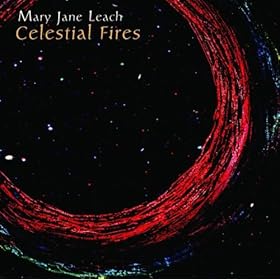 A few months ago, a comment on one of Kyle Gann's posts about online scores led me to the web site of composer Mary Jane Leach, whose interests seemed to overlap considerably with my own. In addition to her description of her music as using difference, combination and interference tones (all of which are important aspects of drone music), one of her long-term projects involves compositions written for multiples: "four or more of one instrument and/or families of like instruments treated as one instrument" (another common characteristic of drone music). So, after browsing her site for a while, I picked up her album Celestial Fires for an introduction to her work.
A few months ago, a comment on one of Kyle Gann's posts about online scores led me to the web site of composer Mary Jane Leach, whose interests seemed to overlap considerably with my own. In addition to her description of her music as using difference, combination and interference tones (all of which are important aspects of drone music), one of her long-term projects involves compositions written for multiples: "four or more of one instrument and/or families of like instruments treated as one instrument" (another common characteristic of drone music). So, after browsing her site for a while, I picked up her album Celestial Fires for an introduction to her work.What a revelation! The album contains six pieces, four for a eight-voice female choir, interspersed with a piece for seven bassoons and a piece for live and taped alto flute and voice. The opening piece, Bruckstück, is one of the most gorgeous pieces of music I've heard in a long time. It's based on a fragment of the Adagio of Anton Bruckner's Eighth Symphony, which is one of my desert island symphonies — hearing this symphony live back in Dayton reawakened a long-dormant interest in orchestras in general, and the nineteenth century symphony in particular. Bruckner's penchant for long, slow symphonies is a precursor for similar qualities in contemporary music, and he remains one of my favorite orchestral composers. Leach's piece takes a ten-measure section and stretches it out to twelve minutes, with melodic fragments passed between voices and harmonies sustained seemingly forever. The opening and closing moments have all voices sustaining a very subtly shifting harmony, with the lowest voices providing a slow pulse and all voices close to each other, all within an octave, all singing the same vowel sound (which remains fairly constant throughout the piece). The central section widens the span and adds slow arpeggios and hemiolas, using one of Bruckner's favorite devices, and reminiscent of Steve Reich as well.
Where Bruckstück takes its inspiration from Bruckner's romantic harmonies, two of the other vocal pieces look further back, to Claudio Monteverdi, the late-16th century Italian madrigal composer. Green Mountain Madrigal uses a lyric from a fragment of one of Monteverdi's operas, with the singers staying in fairly close proximity to each other throughout, passing the melody from one singer to the next. The harmony concentrates more on the dissonances and suspensions rather than open chords, which gives the piece a denser texture than Bruckstück. Mountain Echoes, also based on a Monteverdi madrigal, and Ariel's Song, which uses open vowels like Bruckstück, both use antiphonal effects that are difficult to hear on the stereo recording. They both remind me a little bit of Meredith Monk's music, although without the radical timbre changes that Monk uses. There is less use of sustaining tones and more quickly moving phrases in these two pieces. Leach has an old church in upstate New York which she uses as a performance space; it would be wonderful to hear these pieces with the singers distributed properly.
The first instrumental piece, Feu de Joie, is for seven bassoons, one live and six on tape. It starts with the taped bassoons playing the same note in three different octaves, which sets up a delicious drone for the soloist to hover around. The taped instruments retain their sustaining role, one of the bassoons playing the same low G for the entire duration of the piece, but a few of them eventually add some rhythmic figures to give the piece its shimmering pulse. The overtones combine to create a rich sound throughout, while the soloist plays a melody that covers the entire range of the bassoon. The other one, Trio for Duo, is for two alto flutes and two voices (one each live and on tape), where the voice sounds very similar to the flute. The piece consists of each part playing first in unison, then slowly moving to nearby pitches in glissandi, so that the combination and difference tones become audible. In an ideal concert performance, the two instrumentalists should be amplified and each part's speaker should be in a corner of the auditorium, so that the subtle shifts in pitch are audible in space as well, but the recording is limited to stereo panning between the two channels.
Celestial Fires was Leach's first solo album, and was released in 1993, but music like this is ageless. The CD is still in print, and the album is also available via digital distribution via emusic, Amazon, and iTunes. For an added bonus, Leach's web site has the scores for all six pieces (although Bruckstück was revised a few years ago for six voices instead of eight). Her web site also has a long list of compositions for multiples, which will be a resource for exploration in times to come.

No comments:
Post a Comment